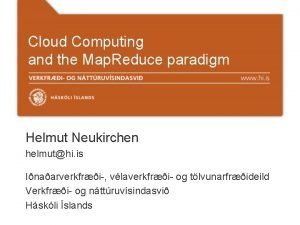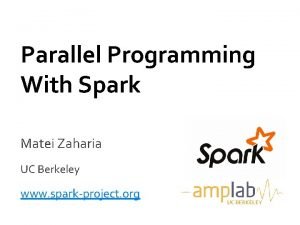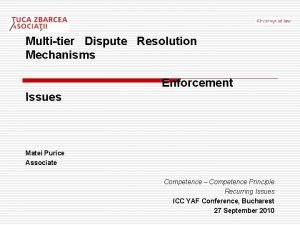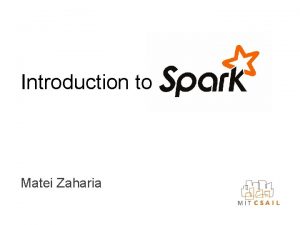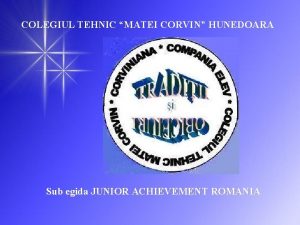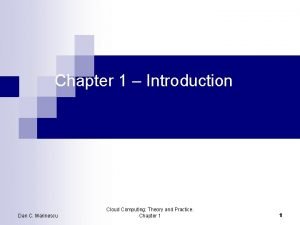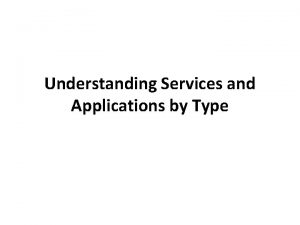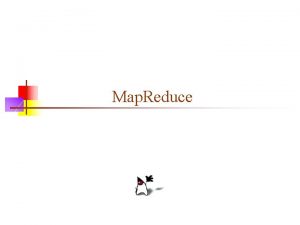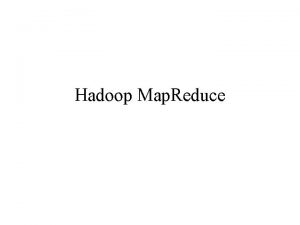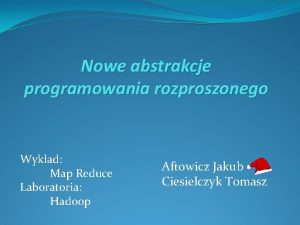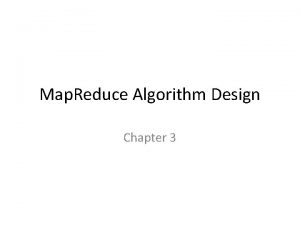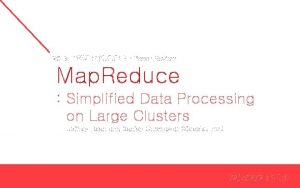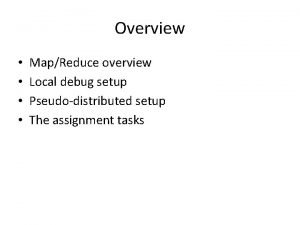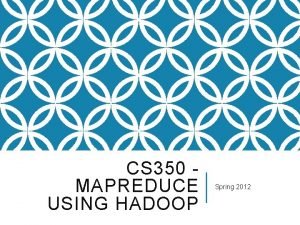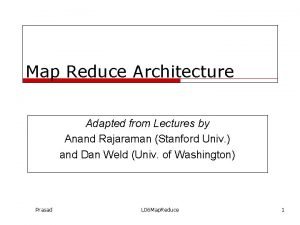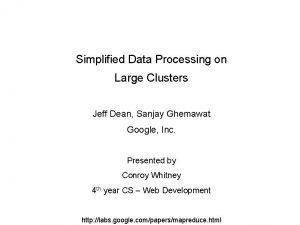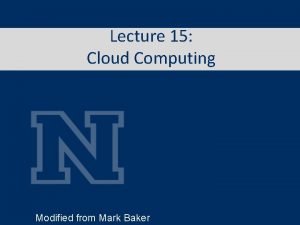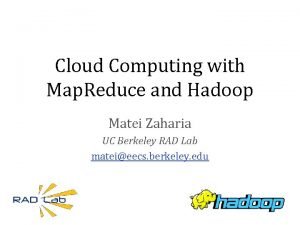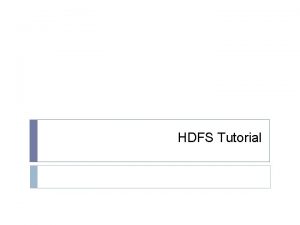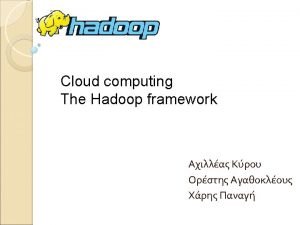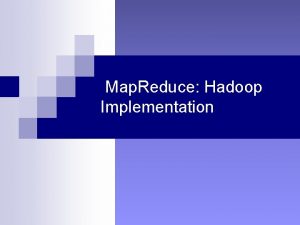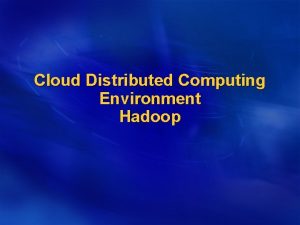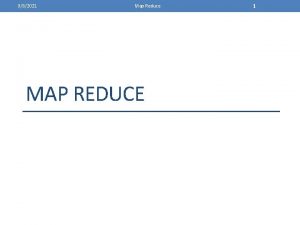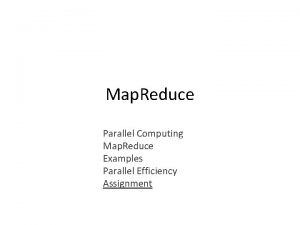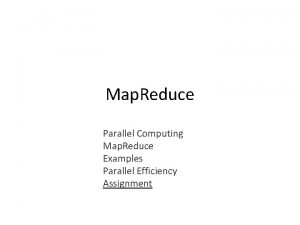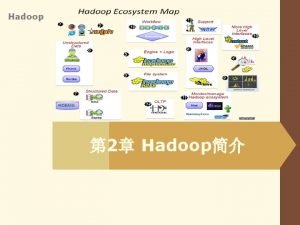Cloud Computing with Map Reduce and Hadoop Matei



































![Word Count in Java public static void main(String[] args) throws Exception { Job. Conf Word Count in Java public static void main(String[] args) throws Exception { Job. Conf](https://slidetodoc.com/presentation_image_h/3789c5fe59d6dfdf76f8ff47f2adbef8/image-36.jpg)





























- Slides: 65

Cloud Computing with Map. Reduce and Hadoop Matei Zaharia UC Berkeley AMP Lab matei@eecs. berkeley. edu

What is Cloud Computing? • “Cloud” refers to large Internet services running on 10, 000 s of machines (Google, Facebook, etc) • “Cloud computing” refers to services by these companies that let external customers rent cycles – Amazon EC 2: virtual machines at 8. 5¢/hour, billed hourly – Amazon S 3: storage at 15¢/GB/month – Windows Azure: applications using Azure API • Attractive features: – Scale: 100 s of nodes available in minutes – Fine-grained billing: pay only for what you use – Ease of use: sign up with credit card, get root access

What is Map. Reduce? • Data-parallel programming model for clusters of commodity machines • Pioneered by Google – Processes 20 PB of data per day • Popularized by Apache Hadoop project – Used by Yahoo!, Facebook, Amazon, …

What is Map. Reduce Used For? • At Google: – Index building for Google Search – Article clustering for Google News – Statistical machine translation • At Yahoo!: – Index building for Yahoo! Search – Spam detection for Yahoo! Mail • At Facebook: – Data mining – Ad optimization – Spam detection

Example: Facebook Lexicon www. facebook. com/lexicon

Example: Facebook Lexicon www. facebook. com/lexicon

What is Map. Reduce Used For? • In research: – Analyzing Wikipedia conflicts (PARC) – Natural language processing (CMU) – Bioinformatics (Maryland) – Particle physics (Nebraska) – Ocean climate simulation (Washington) – <Your application here>

Outline • • • Map. Reduce architecture Sample applications Introduction to Hadoop Higher-level query languages: Pig & Hive Cloud programming research Clouds and HPC

Map. Reduce Goals • Scalability to large data volumes: – Scan 100 TB on 1 node @ 50 MB/s = 24 days – Scan on 1000 -node cluster = 35 minutes • Cost-efficiency: – Commodity nodes (cheap, but unreliable) – Commodity network (low bandwidth) – Automatic fault-tolerance (fewer admins) – Easy to use (fewer programmers)

Typical Hadoop Cluster Aggregation switch Rack switch • 40 nodes/rack, 1000 -4000 nodes in cluster • 1 Gbps bandwidth in rack, 8 Gbps out of rack • Node specs (Facebook): 8 -16 cores, 32 GB RAM, 8× 1. 5 TB disks, no RAID

Typical Hadoop Cluster

Challenges of Cloud Environment • Cheap nodes fail, especially when you have many – Mean time between failures for 1 node = 3 years – MTBF for 1000 nodes = 1 day – Solution: Build fault-tolerance into system • Commodity network = low bandwidth – Solution: Push computation to the data • Programming distributed systems is hard – Solution: Restricted programming model: users write data-parallel “map” and “reduce” functions, system handles work distribution and failures

Hadoop Components • Distributed file system (HDFS) – Single namespace for entire cluster – Replicates data 3 x for fault-tolerance • Map. Reduce framework – Runs jobs submitted by users – Manages work distribution & fault-tolerance – Colocated with file system

Hadoop Distributed File System • Files split into 128 MB blocks • Blocks replicated across several datanodes (often 3) • Namenode stores metadata (file names, locations, etc) • Optimized for large files, sequential reads • Files are append-only Namenode 1 2 4 2 1 3 1 4 3 Datanodes File 1 1 2 3 4 3 2 4

Map. Reduce Programming Model • Data type: key-value records • Map function: (Kin, Vin) list(Kinter, Vinter) • Reduce function: (Kinter, list(Vinter)) list(Kout, Vout)

Example: Word Count def mapper(line): foreach word in line. split(): output(word, 1) def reducer(key, values): output(key, sum(values))

Word Count Execution Input the quick brown fox the fox ate the mouse how now brown cow Map Shuffle & Sort Reduce the, 1 brown, 1 fox, 1 Reduce brown, 2 fox, 2 how, 1 now, 1 the, 3 Reduce ate, 1 cow, 1 mouse, 1 quick, 1 the, 1 fox, 1 the, 1 Map how, 1 now, 1 brown, 1 Map Output quick, 1 ate, 1 mouse, 1 cow, 1

An Optimization: The Combiner • Local reduce function for repeated keys produced by same map • For associative ops. like sum, count, max • Decreases amount of intermediate data • Example: local counting for Word Count: def combiner(key, values): output(key, sum(values))

Word Count with Combiner Input the quick brown fox Map Shuffle & Sort Reduce the, 1 brown, 1 fox, 1 Reduce brown, 2 fox, 2 how, 1 now, 1 the, 3 Reduce ate, 1 cow, 1 mouse, 1 quick, 1 the, 2 fox, 1 the fox ate the mouse how now brown cow Map how, 1 now, 1 brown, 1 Map Output quick, 1 ate, 1 mouse, 1 cow, 1

Map. Reduce Execution Details • Mappers preferentially scheduled on same node or same rack as their input block – Minimize network use to improve performance • Mappers save outputs to local disk before serving to reducers – Allows recovery if a reducer crashes – Allows running more reducers than # of nodes

Fault Tolerance in Map. Reduce 1. If a task crashes: – Retry on another node • OK for a map because it had no dependencies • OK for reduce because map outputs are on disk – If the same task repeatedly fails, fail the job or ignore that input block Ø Note: For the fault tolerance to work, user tasks must be deterministic and side-effect-free

Fault Tolerance in Map. Reduce 2. If a node crashes: – Relaunch its current tasks on other nodes – Relaunch any maps the node previously ran • Necessary because their output files were lost along with the crashed node

Fault Tolerance in Map. Reduce 3. If a task is going slowly (straggler): – Launch second copy of task on another node – Take the output of whichever copy finishes first, and kill the other one • Critical for performance in large clusters (many possible causes of stragglers)

Takeaways • By providing a restricted data-parallel programming model, Map. Reduce can control job execution in useful ways: – Automatic division of job into tasks – Placement of computation near data – Load balancing – Recovery from failures & stragglers

Outline • • • Map. Reduce architecture Sample applications Introduction to Hadoop Higher-level query languages: Pig & Hive Cloud programming research Clouds and HPC

1. Search • Input: (line. Number, line) records • Output: lines matching a given pattern • Map: if(line matches pattern): output(line) • Reduce: identity function – Alternative: no reducer (map-only job)

2. Sort • Input: (key, value) records • Output: same records, sorted by key • Map: identity function • Reduce: identify function zebra cow Map • Trick: Pick partitioning function p such that k 1 < k 2 => p(k 1) < p(k 2) ant, bee Map pig aardvark, elephant Map sheep, yak Reduce [A-M] aardvark ant bee cow elephant Reduce [N-Z] pig sheep yak zebra

3. Inverted Index • Input: (filename, text) records • Output: list of files containing each word • Map: foreach word in text. split(): output(word, filename) • Combine: uniquify filenames for each word • Reduce: def reduce(word, filenames): output(word, sort(filenames))

Inverted Index Example hamlet. txt to be or not to be 12 th. txt be not afraid of greatness to, hamlet. txt be, hamlet. txt or, hamlet. txt not, hamlet. txt be, 12 th. txt not, 12 th. txt afraid, 12 th. txt of, 12 th. txt greatness, 12 th. txt afraid, (12 th. txt) be, (12 th. txt, hamlet. txt) greatness, (12 th. txt) not, (12 th. txt, hamlet. txt) of, (12 th. txt) or, (hamlet. txt) to, (hamlet. txt)

4. Most Popular Words • Input: (filename, text) records • Output: the 100 words occurring in most files • Two-stage solution: – Job 1: • Create inverted index, giving (word, list(file)) records – Job 2: • Map each (word, list(file)) to (count, word) • Sort these records by count as in sort job • Optimizations: – Map to (word, 1) instead of (word, file) in Job 1 – Estimate count distribution in advance by sampling

5. Numerical Integration • Input: (start, end) records for sub-ranges to integrate – Can implement using custom Input. Format • Output: integral of f(x) over entire range • Map: def map(start, end): sum = 0 for(x = start; x < end; x += step): sum += f(x) * step output(“”, sum) • Reduce: def reduce(key, values): output(key, sum(values))

Outline • • • Map. Reduce architecture Sample applications Introduction to Hadoop Higher-level query languages: Pig & Hive Cloud programming research Clouds and HPC

Introduction to Hadoop • Download from hadoop. apache. org • To install locally, unzip and set JAVA_HOME • Docs: hadoop. apache. org/common/docs/current • Three ways to write jobs: – Java API – Hadoop Streaming (for Python, Perl, etc) – Pipes API (C++)

Word Count in Java public static class Map. Class extends Map. Reduce. Base implements Mapper<Long. Writable, Text, Int. Writable> { private final static Int. Writable ONE = new Int. Writable(1); public void map(Long. Writable key, Text value, Output. Collector<Text, Int. Writable> output, Reporter reporter) throws IOException { String line = value. to. String(); String. Tokenizer itr = new String. Tokenizer(line); while (itr. has. More. Tokens()) { output. collect(new Text(itr. next. Token()), ONE); } } }

Word Count in Java public static class Reduce extends Map. Reduce. Base implements Reducer<Text, Int. Writable, Text, Int. Writable> { public void reduce(Text key, Iterator<Int. Writable> values, Output. Collector<Text, Int. Writable> output, Reporter reporter) throws IOException { int sum = 0; while (values. has. Next()) { sum += values. next(). get(); } output. collect(key, new Int. Writable(sum)); } }
![Word Count in Java public static void mainString args throws Exception Job Conf Word Count in Java public static void main(String[] args) throws Exception { Job. Conf](https://slidetodoc.com/presentation_image_h/3789c5fe59d6dfdf76f8ff47f2adbef8/image-36.jpg)
Word Count in Java public static void main(String[] args) throws Exception { Job. Conf conf = new Job. Conf(Word. Count. class); conf. set. Job. Name("wordcount"); conf. set. Mapper. Class(Map. Class. class); conf. set. Combiner. Class(Reduce. class); conf. set. Reducer. Class(Reduce. class); File. Input. Format. set. Input. Paths(conf, args[0]); File. Output. Format. set. Output. Path(conf, new Path(args[1])); conf. set. Output. Key. Class(Text. class); // out keys are words (strings) conf. set. Output. Value. Class(Int. Writable. class); // values are counts Job. Client. run. Job(conf); }

Word Count in Python with Hadoop Streaming Mapper. py: Reducer. py: import sys for line in sys. stdin: for word in line. split(): print(word. lower() + "t" + 1) import sys counts = {} for line in sys. stdin: word, count = line. split("t") dict[word] = dict. get(word, 0) + int(count) for word, count in counts: print(word. lower() + "t" + 1)

Amazon Elastic Map. Reduce • Web interface and command-line tools for running Hadoop jobs on EC 2 • Data stored in Amazon S 3 • Monitors job and shuts machines after use • Can also create Hadoop clusters manually using scripts included with Hadoop

Elastic Map. Reduce UI

Elastic Map. Reduce UI

Elastic Map. Reduce UI

Outline • • • Map. Reduce architecture Sample applications Introduction to Hadoop Higher-level query languages: Pig & Hive Cloud programming research Clouds and HPC

Motivation • Map. Reduce is powerful: many algorithms can be expressed as a series of MR jobs • But it’s fairly low-level: must think about keys, values, partitioning, etc. • Can we capture common “job patterns”?

Pig • Started at Yahoo! Research • Runs about 50% of Yahoo!’s jobs • Features: – Expresses sequences of Map. Reduce jobs – Data model: nested “bags” of items – Provides relational (SQL) operators (JOIN, GROUP BY, etc) – Easy to plug in Java functions

An Example Problem Suppose you have user data in one file, website data in another, and you need to find the top 5 most visited pages by users aged 18 -25. Load Users Load Pages Filter by age Join on name Group on url Count clicks Order by clicks Take top 5 Example from http: //wiki. apache. org/pig-data/attachments/Pig. Talks. Papers/attachments/Apache. Con. Europe 09. ppt

In Map. Reduce Example from http: //wiki. apache. org/pig-data/attachments/Pig. Talks. Papers/attachments/Apache. Con. Europe 09. ppt

In Pig Latin Users = load ‘users’ as (name, age); Filtered = filter Users by age >= 18 and age <= 25; Pages = load ‘pages’ as (user, url); Joined = join Filtered by name, Pages by user; Grouped = group Joined by url; Summed = foreach Grouped generate group, count(Joined) as clicks; Sorted = order Summed by clicks desc; Top 5 = limit Sorted 5; store Top 5 into ‘top 5 sites’; Example from http: //wiki. apache. org/pig-data/attachments/Pig. Talks. Papers/attachments/Apache. Con. Europe 09. ppt

Translation to Map. Reduce Notice how naturally the components of the job translate into Pig Latin. Load Users Load Pages Filter by age Join on name Group on url Count clicks Order by clicks Users = load … Filtered = filter … Pages = load … Joined = join … Grouped = group … Summed = … count()… Sorted = order … Top 5 = limit … Take top 5 Example from http: //wiki. apache. org/pig-data/attachments/Pig. Talks. Papers/attachments/Apache. Con. Europe 09. ppt

Translation to Map. Reduce Notice how naturally the components of the job translate into Pig Latin. Load Users Load Pages Filter by age Join on name Job 1 Group on url Job 2 Count clicks Order by clicks Users = load … Filtered = filter … Pages = load … Joined = join … Grouped = group … Summed = … count()… Sorted = order … Top 5 = limit … Job 3 Take top 5 Example from http: //wiki. apache. org/pig-data/attachments/Pig. Talks. Papers/attachments/Apache. Con. Europe 09. ppt

Hive • Developed at Facebook • Used for most Facebook jobs • Relational database built on Hadoop – Maintains table schemas – SQL-like query language (which can also call Hadoop Streaming scripts) – Supports table partitioning, complex data types, sampling, some query optimization

Summary • Map. Reduce’s data-parallel programming model hides complexity of distribution and fault tolerance • Principal philosophies: – Make it scale, so you can throw hardware at problems – Make it cheap, saving hardware, programmer and administration costs (but necessitating fault tolerance) • Hive and Pig further simplify programming • Map. Reduce is not suitable for all problems, but when it works, it may save you a lot of time

Outline • • • Map. Reduce architecture Sample applications Introduction to Hadoop Higher-level query languages: Pig & Hive Cloud programming research Clouds and HPC

Cloud Programming Research • Many other projects follow Map. Reduce’s example of restricting the programming model for efficient execution in datacenters – Dryad (Microsoft): general DAG of tasks – Pregel (Google): bulk synchronous processing – Percolator (Google): incremental computation – S 4 (Yahoo!): streaming computation – Piccolo (NYU): shared in-memory state – Dryad. LINQ (Microsoft): language integration

Self-Serving Example: Spark • Motivation: iterative jobs (common in machine learning, optimization, etc) • Problem: iterative jobs reuse the same working set of data over and over, but Map. Reduce / Dryad / etc require acyclic data flows • Solution: “resilient distributed datasets” that are cached in memory but can be rebuilt on failure

Spark Data Flow w f(x, w) x f(x, w) w w x x f(x, w) . . . Map. Reduce, Dryad Spark

Example: Logistic Regression Goal: find best line separating 2 datasets random initial line + + + – – – – target

Serial Version val data = read. Data(. . . ) var w = Vector. random(D) for (i <- 1 to ITERATIONS) { var gradient = Vector. zeros(D) for (p <- data) { val scale = (1/(1+exp(-p. y*(w dot p. x))) - 1) * p. y gradient += scale * p. x } w -= gradient } println("Final w: " + w) Scala programming language

Spark Version val data = spark. text. File(. . . ). map(read. Point). cache() var w = Vector. random(D) for (i <- 1 to ITERATIONS) { var gradient = data. map { p => val scale = (1/(1+exp(-p. y*(w dot p. x))) - 1) * p. y scale * p. x }. reduce(_ + _) w -= gradient } println("Final w: " + w)

Spark Performance 127 s / iteration first iteration 174 s further iterations 6 s

Interactive Spark • Ability to cache datasets in memory is great for interactive data analysis: extract a working set, cache it, query it repeatedly • Modified Scala interpreter to support interactive use of Spark • Result: full-text search of Wikipedia in 0. 5 s after 20 -second initial load

Outline • • • Map. Reduce architecture Sample applications Introduction to Hadoop Higher-level query languages: Pig & Hive Cloud programming research Clouds and HPC

Can HPC Run in the Cloud? • EC 2 gives full Linux VMs, so you can run MPI • Main question is performance: – Cloud data centers often use 1 Gbps Ethernet, which is much slower than supercomputer networks – Virtual machines may perform heterogeneously • Studies show poor performance for communication intensive codes, but OK for less intensive ones • New HPC EC 2 nodes may help: 10 Gbps Ethernet, optionally 2× Nvidia Tesla GPUs

EC 2 Latency vs Infiniband Source: Edward Walker. Benchmarking Amazon EC 2 for High Performance Computing. ; login: , vol. 33, no. 5, 2008.

HPC Cloud Projects • Magellan (DOE, Argonne, LBNL) – 720 nodes, 5760 cores, Infini. Band network – Goals: explore suitability of cloud model, APIs and hardware to scientific computing, and implications on security and cost • SGI HPC Cloud (“Cyclone”) – Commercial on-demand HPC offering – Includes CPU and GPU nodes – Includes “software as a service” for select domains • Probably others as well

Resources • Hadoop: http: //hadoop. apache. org/common • Pig: http: //hadoop. apache. org/pig • Hive: http: //hadoop. apache. org/hive • Video tutorials: www. cloudera. com/hadooptraining • Amazon Elastic Map. Reduce: http: //docs. amazonwebservices. com/Elastic. Map. Redu ce/latest/Getting. Started. Guide/
 What is hadoop i/o
What is hadoop i/o Seven step model of migration into cloud
Seven step model of migration into cloud Distributed computing hadoop
Distributed computing hadoop Apache atlas architecture
Apache atlas architecture Map reducing in cloud computing
Map reducing in cloud computing Conventional computing and intelligent computing
Conventional computing and intelligent computing Matei zaharia
Matei zaharia Matei purice
Matei purice Matei zaharia age
Matei zaharia age Dispozitie eutimica
Dispozitie eutimica Liceul matei basarab craiova
Liceul matei basarab craiova Colegiul tehnic matei corvin hunedoara
Colegiul tehnic matei corvin hunedoara Dr cristina matei
Dr cristina matei Matei 28 19
Matei 28 19 Grupeaza dupa modelul de la exercitiul 1
Grupeaza dupa modelul de la exercitiul 1 571r distribution center
571r distribution center Matei zaharia spark
Matei zaharia spark Matei purice
Matei purice Matei 22
Matei 22 Matei purice
Matei purice Adp secure client login pearltrees
Adp secure client login pearltrees Virtualization tools and mechanisms in cloud computing
Virtualization tools and mechanisms in cloud computing Distributed system models in cloud computing
Distributed system models in cloud computing Social networks and groupware in cloud computing
Social networks and groupware in cloud computing The land fatma omara
The land fatma omara Dan c. marinescu
Dan c. marinescu Cloud computing presentation
Cloud computing presentation Cloud computing benefits and risks
Cloud computing benefits and risks Pods aggregation and silos in cloud computing
Pods aggregation and silos in cloud computing Grid and cloud computing lmu
Grid and cloud computing lmu Cloud computing places the processing and
Cloud computing places the processing and Grid and cloud computing definition
Grid and cloud computing definition Map reduce join
Map reduce join Map reduce types
Map reduce types Map reduce architecture
Map reduce architecture Google map reduce
Google map reduce Map reduce combine
Map reduce combine Mapreduce combiner
Mapreduce combiner Document
Document Map reduce paper
Map reduce paper Map-reduce
Map-reduce Map reduce program
Map reduce program Map-reduce
Map-reduce Map reduce dashboard
Map reduce dashboard Lisp map reduce
Lisp map reduce Java map reduce
Java map reduce Lisp map reduce
Lisp map reduce Google map reduce
Google map reduce Vodafone cloud server
Vodafone cloud server Hardware assisted virtualization in cloud computing
Hardware assisted virtualization in cloud computing Clouds definition
Clouds definition Cloud computing reference model
Cloud computing reference model Ardcs
Ardcs Pay per use monitor
Pay per use monitor Green computing seminar
Green computing seminar Scalability issues in cloud computing
Scalability issues in cloud computing Elastic computing
Elastic computing Cloud unified management
Cloud unified management Nist cloud computing security reference architecture
Nist cloud computing security reference architecture Nimbus architecture in cloud computing
Nimbus architecture in cloud computing Cloud computing cambridge
Cloud computing cambridge Case study on microsoft azure in cloud computing
Case study on microsoft azure in cloud computing Cloud computing layers
Cloud computing layers Regarder introduction to cloud computing
Regarder introduction to cloud computing Sejarah cloud computing
Sejarah cloud computing Petr palas
Petr palas




